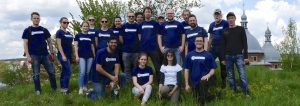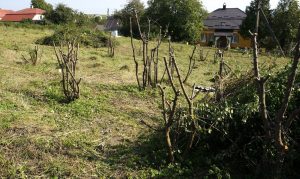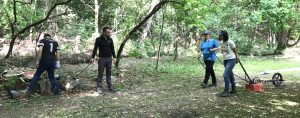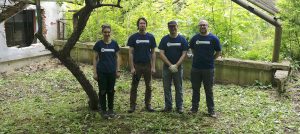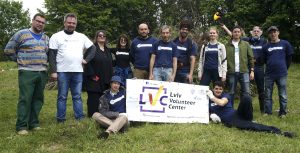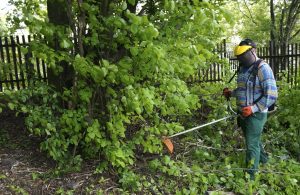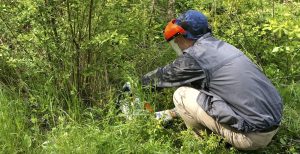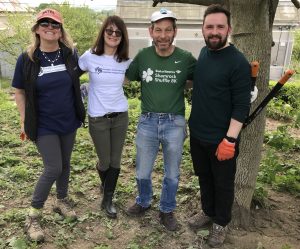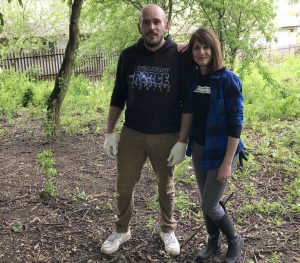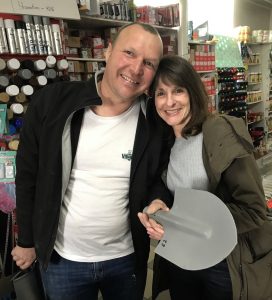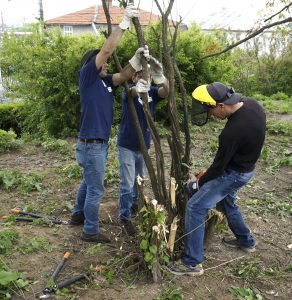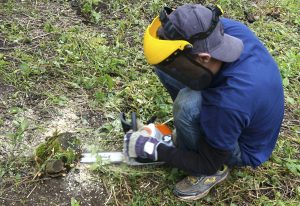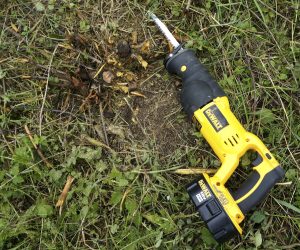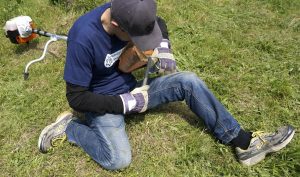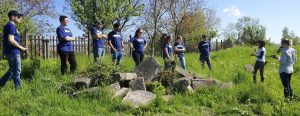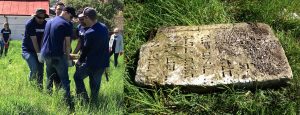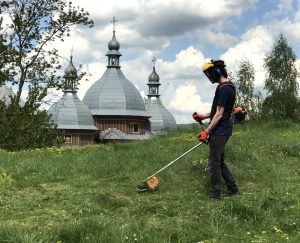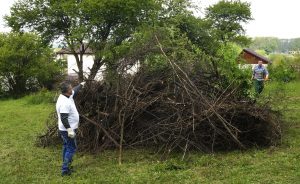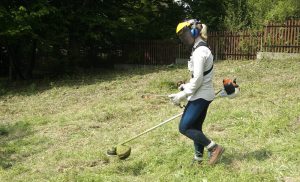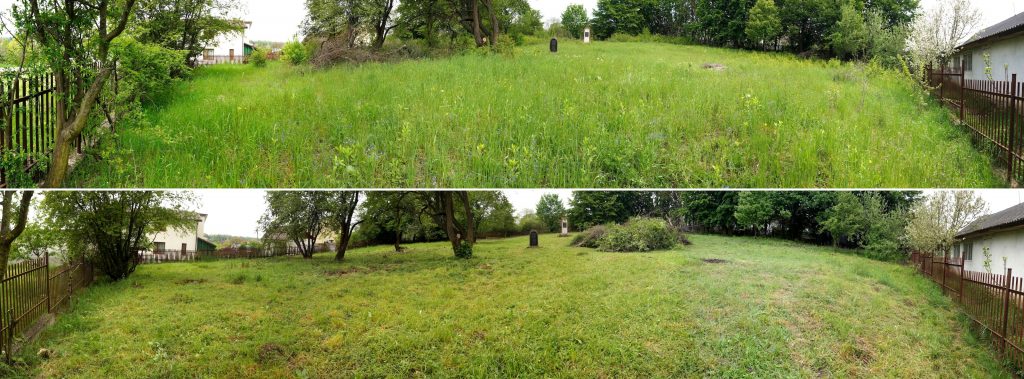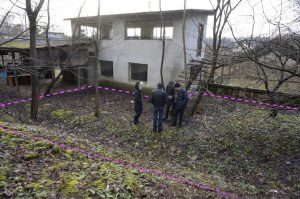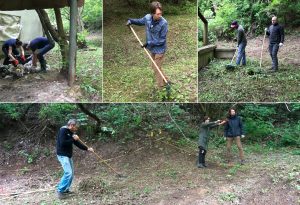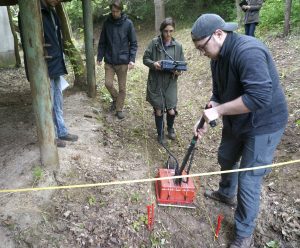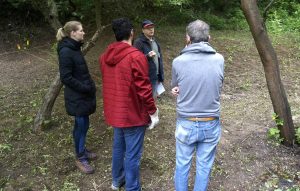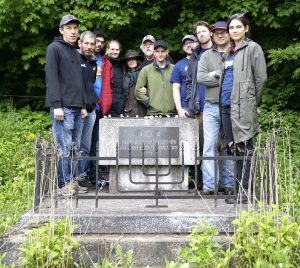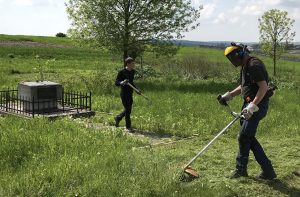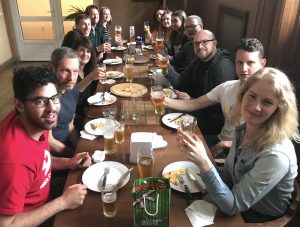Last week, Marla and I were very pleased to work for several days alongside old and new friends from Rohatyn, around Ukraine, and beyond, continuing our effort to clear and condition the vegetation and grounds of Rohatyn’s four Jewish burial sites (old and new Jewish cemeteries, and north and south wartime mass graves). This first major volunteer event of 2019 for Rohatyn Jewish Heritage follows a five-day clearing project at the old cemetery in August last year, and two follow-up work days there, plus an intensive day tackling thorn bushes and wild shrubs at the new cemetery last July. We also cleared around the memorial monuments at the two wartime mass grave sites, and were fortunate to have expert supplemental research performed at one of those sites.
![]() Ця стаття також доступна українською.
Ця стаття також доступна українською.
Throughout the warm-weather months of 2019, we will continue to work alone and (we hope!) with other volunteers at all of the sites, building on the efforts of this hard-working crew. We’d like to share with you here the great progress made so far…
Our Goals for this Event
2018 was a critical development and learning year for RJH, and we were fortunate to have the guidance and skill of individuals associated with three volunteer charity organizations, The Matzevah Foundation (TMF), the Lviv Volunteer Center (LVC), and many Peace Corps Volunteers (PCVs), all working with us in the summer months. With their leadership and their amazing efforts, important baseline clearing of most of the old cemetery and half of the new cemetery was accomplished, and in the process we learned how to effectively use the equipment, organize the work, and protect the safety of both the volunteers and the tools. This year we aim to extend both the clearing and our learning as we proceed. Our goals for this first event of 2019 included:
- clearing heavy shrubs from several sections of the cemeteries (residual from 2018)
- cutting and clearing new grass and light shrubs from portions of all four burial grounds (a perennial task)
- suppressing new growth of woody shrubs wherever possible
- cutting and grinding stumps of large shrubs and small trees down to the ground surface, to reduce trip hazards and simplify future maintenance
- continuing to clear hard debris and garbage from the cemeteries
One unique group of volunteers at this event also made it possible to accomplish a special task in addition to groundskeeping: a supplemental non-invasive archaeological survey at the north mass grave site. More information and images from this very fortunate opportunity are below.
Local and Global Volunteers
The photos here only begin to illustrate how important to the success of this event were the many hands and hearts who came to work with us, joining their strengths with others to accomplish work far too large for our small organization alone. Those who came from a distance each managed their own transport, and for those staying for more than a day, also their local accommodations, simplifying the work and project cost to our NGO. Marla and I are especially grateful to the Rohatyn citizens, students and others, who labored with the many visitors and chatted with neighbors to help integrate these sites into the city’s heritage, as well as the city’s shopkeepers and the staffs at local gas stations, hotels, and eateries who cheerfully kept us well supplied. We were also very pleased to take a couple of breaks from our work to give informal tours of the Jewish sites for both locals and visitors, putting the current sites into their historical and cultural context. We are humbled by the generosity of all of the volunteers and other supporters, and we wish to acknowledge their kind charity here.
Staffordshire University Centre of Archaeology
The timing for this volunteer event was set by an opportunity presented to us by the Centre of Archaeology at Staffordshire University in the UK; a team led by the Centre’s director Dr. Caroline Sturdy Colls conducted our largest project in 2017, a non-invasive survey of Rohatyn’s two mass grave sites and the new Jewish cemetery. This year, a social action grant permitted four members of Caroline’s team to donate their expertise in further survey work at the north mass grave site, and also to join the other volunteers in heavy hand work over three days at both cemeteries and in preparation for the survey at the north mass grave.
We were very pleased to welcome back Kevin Colls, the Centre’s archaeological project manager, and to meet the Centre’s long-time project archaeologist Will Mitchell, PhD researcher Daria Cherkaska, and undergraduate researcher Alex Haycock. Our relationship with the Centre has developed for more than three years; we remain in awe of their research and reporting at sites of conflict throughout Europe. We admire their courage as much as their science, and we look forward to continuing our work together with the Centre and their partners.
Peace Corps Volunteers
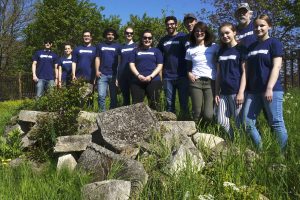
PCVs with RJH, students, and other volunteers; left to right: Andrés, Marta, Bob, Alex, Carson, Serena, Ethan, Vasyl, Marla, Daryna, Jay, and Sofiya. Photo © 2019 RJH.
We were overwhelmed last year by the kindness of many volunteers in service in Ukraine for the Peace Corps who helped us over many days in Rohatyn, at other sites in western Ukraine, and leading their own history and heritage projects as well; in addition to their social work, they make outstanding informal ambassadors for America. Last week we were very pleased to meet six PCVs working this year for Peace Corps in Ukraine, who reinforced what we had learned before: that PCVs are exceptional people, highly-motivated volunteers with strong problem-solving skills and a constant focus on building bridges to mutual understanding. Plus: they’re very curious, which gave Marla and me many opportunities to tell “the Rohatyn story” in its multicultural depth. In exchange, each of the volunteers also brought to us stories from their home towns around Ukraine and back in America, which helps us appreciate their breadth of experience.
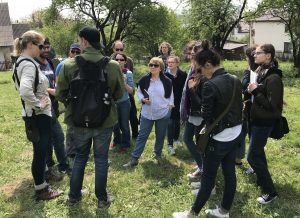
Andrés explaining the Peace Corps program to visitors from Warsaw University’s Jewish Studies program. Photo © 2019 RJH.
Another key component of their support was self-management and leadership, taking that burden from us so we could focus on other practical issues. Our friend and the current PCV in Rohatyn, Andrés Rodriguez, took on much of the advance planning for himself and his peers, including local coordination of lodging, transport, and meals, plus day-to-day organization and communication within the group and with the local community, in addition to laboring with us on each of the days, and while still continuing his teaching responsibilities at his assigned school in Rohatyn. We owe a huge thank-you to Andrés for offering and then so skillfully managing these responsibilities.
Catching the fast-moving PCVs on camera at the sites last week proved difficult, but you should find here images of Andrés together with his colleagues Serena Berkowitz (serving in Sumy), Carson Holstein (Brody), Bob Minton (Mukachevo), Ethan Scharf (Ilnytsia, near Khust), and Leslie Nolan (Nadvirna). It’s no surprise to us that in many of the images you’ll see the PCVs smiling, engaged with other volunteers and local people in friendly exchanges.
Lviv Volunteer Center
Our dear friends at the Lviv Volunteer Center of All-Ukrainian Jewish Charitable Foundation Hesed-Arieh once again gave their time and energy to what is now their fourth charity working day with us in the new cemetery in Rohatyn since 2017. We have joined the LVC on several of the projects they have led in and around Lviv during the past years, but we can never match their strength and adaptability, for which we are grateful. Because of their depth of experience, we can also count on them for guidance when we face complications at the sites with tools, vegetation, or other obstacles. And they are fearless – it makes us laugh when they warn us to be careful around nasty thorn bushes or other threats, and then dive in themselves to tear out the plants.
LVC members and their leader Sasha Nazar organize local and international volunteer events with and without Jewish heritage themes, including assistance and support for children and for local elders. Many of their work camps bring together Ukrainian and foreign youth for teaching and community service efforts, which always involve touring and studying regional shared histories. It is an honor for us to work alongside them and contribute in whatever small ways we can, and we are looking forward to participating in their projects in August this year.
From among the large LVC cadre of friends and volunteers, we were very happy to welcome last week Sasha Nazar, Slava Durach, Arie Lisakoff, Misha Borodovsky, and Anne Urech, all of whom we have worked with before in Lviv and Rohatyn, and at other volunteer heritage days in Staryi Sambir, Boryslav, Kalush, and Ralivka, among others. Their determined efforts especially at the Rohatyn new Jewish cemetery are making a very visible difference.
Rohatyn High School Student Leaders
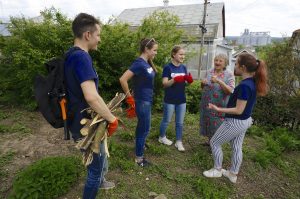
Andrés with students Marta, Sofiya, and Daryna, speaking at the old cemetery with a neighbor. Photo © 2019 RJH.
A special treat for us on Sunday was the full-day participation of three students from Rohatyn’s specialized secondary school #1, who are prominent in the city’s “Leader” program for young civil society activists. Organized and promoted by Andrés Rodriguez, the Peace Corps Volunteer who also teaches English classes at the school, the program and its members seek to develop the character and skills of thoughtful and responsible citizens, and the desire and ability to help people in their community.
In addition to their hard work clearing and cleaning in the old cemetery, the students also helped us exchange greetings and information with cemetery neighbors, and they shared their experiences of school and life in Rohatyn with the PCVs and other visitors through the day. Having them with us on a Jewish heritage tour around Rohatyn means they can help explain about the history of the Jewish community to their peers, parents, and neighbors in the future as well.
Our sincere thanks to Daryna Zavhorodnia, Sofiya Slaba, and Marta Kutna for helping out with the clearing work and the social action, and to Andrés again for promoting this event with the student leaders.
Other Local and Foreign Volunteers
As last year, this time we also had helpful support from other residents of Rohatyn, from around Ukraine, and from abroad – people who learned about the project on Facebook and came to lend a hand just because they care about the heritage and about the larger interconnected community. We were very pleased to work at the cemeteries and at the north mass grave site with Oleg Sheremet from Verbylivtsi, just south of Rohatyn; Alex Grigorescu, a tour guide from Bucharest; Steve Shore, an American living in Budapest; and Volodya Hrynishak, who has been working with Leslie Nolan on heritage in his town of Nadvirna. Working hard together as a team and with other volunteers, these new (and now very real) friends made a significant difference at Rohatyn’s heritage sites this past week.
We had very pleasant exchanges with other friends and neighbors in Rohatyn also, including helpful advice and support from four residents who live adjacent to the cemeteries, with selecting plants for removal, with disposal of the shrub cuttings and other green waste, and with repair of the metal fencing around the old cemetery. We hope to be as good a neighbor to these kind people as they are to our Rohatyn ancestors. And we would like to the thank the leadership of the City of Rohatyn, who have committed to disposing of the large amount of cut green waste at the new Jewish cemetery; the City continues to smooth our work in town every year.
On the day before the main clearing event began, we were shopping in Rohatyn for a solution to our problem with a fast-growing poisonous plant (heracleum) at some of the sites, and went to a building supply shop south of the town center, where we met the owner, Roman Maletskiy. When he understood our problem, he demonstrated how he manages the plant himself, then assembled and sharpened a flat shovel to serve as a long-handled knife – and donated the shovel to us for our work! We have already used the shovel at two of the sites in a first attempt to inhibit the noxious plant, and we’ll remember Roman’s kindness when we bring it with us on future visits to continue the experiment.
Once again, as on nearly all of our in-town projects large and small, we leaned very heavily on our dear friend Vasyl Yuzyshyn, who not only shuttled us and other volunteers between sites and for meal and toilet breaks, but also frequently served as interpreter for us all over town. When not needed on those tasks, Vasyl worked as hard as anyone else in the cemeteries, cutting, dragging, and clearing even the heaviest of materials. We are increasingly depending on Vasyl’s technical skills also, to help us solve problems with the machinery and to keep the tools sharp and safe. It is always a pleasure for us to spend our days with such a friendly and helpful ally.
Our Donors and Supporters
This event would not have been possible without the support of many kind donors to our NGO for this project. In addition to the well over 100 individuals and couples who have contributed to offset expenses for the recovery of headstones and maintenance of the heritage sites, who we proudly acknowledge on our donors page, last March more than 20 people helped us quickly raise the funds to purchase two additional power saws to tackle difficult stumps beginning with last week’s event:
Joe Bratspis, Audrey Campbell, André Convers, Rhona Fidler, Edjo Frank, Linda Frank, Dori and Mitchell Glotzer, Les Gluck, Christian Herrmann, Maria Natanson, Stephanie Palumbo, Roumiana Pankova, Marusia Petryshyn, Eliezer Ben Pinchas, Mark Shapiro, Chris Small, Stephan Small, Barbara Steinmetz, Andrea Tzadik, Lori Wasserman, and one donor who prefers to remain anonymous.
And here we have a good opportunity to again thank our long-time supporters who quietly tackle many aspects of our continuing project work from a distance: Tom Traber, who gives us a footing in the US and advises on many technical topics (including one of the saws purchased this spring and used last week in the cemeteries); Ann Harris and Shelley Pollero, who manage and record US-based donations for us through Gesher Galicia; and Wito Nadaszkiewicz and Bohdan Zdanevych, who manage our NGO’s Ukraine-based finances and legal matters through Law Craft Legal Services. We are fortunate to have very good friends backing up our efforts throughout the year.
Our Maturing Collection of Tools and Machinery
As noted above, last week we deployed two new power tools intended to supplement our working collection. One of these new tools is a small gas-powered chain saw, which we had hoped to avoid buying but find necessary for cutting and grinding the stumps of small trees and woody shrubs first felled by loppers and motorized brushcutters, and for occasional trimming the smaller branches of trees. The other new tool is a hand-held battery-powered reciprocating saw, which is also used to cut small stumps flush to the ground to reduce trip hazards and facilitate future groundskeeping with string trimmers.
The two new tools complement each other; each is better at some tasks and stump sizes and types than the other. We have learned in our initial experiments that both tools are fast and effective at cutting stumps to the ground, but because the soil in the cemeteries is very sandy and abrasive, working at the soil surface dulls chains and blades very quickly, so we will need to sharpen and replace the cutting and driving elements quite often. This is another situation in which we need to use tools in ways most others do not, and we must adapt our methods and maintenance cycles to the need.
Also noted above is another tool we have added for addressing a special problem: the long-handled knife we’re now using to cut large stems of the fast-growing and intensely poisonous plant heracleum. This tool (a modified shovel) will be kept segregated from other hand tools because of the noxious and long-term effects of the plant, which cuts easily but grows very rapidly from the root.

A shovel sharpened into a long-handled knife to deal with the poisonous heracleum. Photos © 2019 RJH.
Otherwise we continue to use the stable of hand and motor tools and supplies we assembled last year, which we share with the LVC when they organize clearing projects in the region. The collection is still mostly intact and fully functional, with only normal attrition and wear, and importantly all of the motor tools are still in very good condition. We have already replaced a number of the cutting attachments on the tools (blades, chains, chain bars, and of course string), and filed out nicks and other damage to hand tool blades. We lost two hand tools last year, one saw and one pair of loppers, which are probably still hidden under grass in the very large spaces where we work in Rohatyn and elsewhere in the region. The hand tools have a limited life and we work them hard, so we anticipate replacing many of them later this year or over the next winter.
We are also trying to be attentive to typical working injuries, and keeping appropriate first aid with us at the work sites. Last week we and many of the volunteers suffered scratches and bruises, splinters, hyper-extended joints, and other common “garden” injuries, which we and/or the volunteers themselves were able to care for to prevent infection and further harm. Fortunately none of the volunteers was bitten by ticks or burned by the heracleum plant, or had a serious accident. We carry a first aid kit with us (donated last year by The Matzevah Foundation), but we need to simplify the availability of bandages and antiseptics during each new project.
Old Jewish Cemetery
Before getting started, we spent some time as a group orienting everyone to the cemetery site and its role in the history of the Rohatyn Jewish community. We also discussed our plans for the volunteer event, some practical topics about the tools and the landscape, and safety.
Our project at the old cemetery began with a heavy but rewarding lifting task, before any of the volunteers became too tired: Alex, Vasyl, Bob, Ethan, and Andrés raised and carried by hand a large Jewish headstone fragment which had been returned to the cemetery and left near its eastern gate; they brought the fragment up to the top of the cemetery grounds and placed it near one of the natural paths so it can be viewed easily; in time we will join this fragment with the hundreds of others we have recovered further down the slope.
To start this year’s clearing effort, we focused on cutting and dragging residual wild brush at the northeast and southwest corners of the old cemetery, which we had not quite finished in the major projects last year. PCVs, Rohatyn students, and others divided and worked at both locations, completely clearing the northeast corner and clearing much of the unwanted brush at the southwest corner; in this latter work, we were guided by a neighbor woman, Hanna, who is familiar with the types of plants growing there and helped us select which individual plants should be removed.
As this work day was a Sunday, we postponed running the motor tools until religious services were finished at the nearby historic St. Mykolay wooden church. In the afternoon, the UK archaeology crew (and later, Andrés and I) shouldered the motorized brushcutters to mow grass at the top end of the cemetery; together we cleared perhaps 15% of the cemetery area during those few hours. Also in the afternoon, Vasyl used the new chainsaw to cut back the heavier wild shrubs at the southwest corner, and to start trimming stumps there as well; there are many hundreds of brush and small tree stumps in the cemetery, so this task will continue this year and probably for years to come.
Lots of hands helped to gather hard debris and garbage (bottles, cans, bricks, etc.) which have collected in the cemetery over the past decades; we gathered five large bags of debris but this, too, will be a long-term task for us as there is much more debris on the ground there. A surprising success came after Volodya, Alex, and all of the PCVs spent more than 20 minutes gradually ripping a large, crumpled metal wire mesh tangle from the plants and vines that trapped it on the ground near the center of the cemetery; we are very glad to have that hazard to both people and tools removed at last.
The old cemetery is large, and of course we will need to continue working there through the warm months just to keep grass and vegetation from taking over the site again. We also have more brush removal we want to do, and the long-term tasks of stump and debris removal. We expect to spend several days this year focused only on the old cemetery, and will alert potential volunteers to those events via social media.
New Jewish Cemetery
The new cemetery saw an intense effort for a full day, with remarkably positive visual and practical effect. Focusing on the harder wild plants, and continuing their heavy work from past years, the LVC cut woody shrubs throughout the cemetery using both motor and hand tools, and Misha used the chainsaw to shape the ragged trees at the western side. The LVC, PCVs, the archaeologists, and other volunteers untangled and moved cut branches and other green waste from the 2018 clearing project to the center of the cemetery where it can be burned along with new materials cut and dragged during this day. After the heavier brush was cut, we also began mowing new grass, but we will follow up on that on a later project date this year.
When not clearing vegetation, several volunteers collected debris and garbage as well; however, quite a lot still remains in the cemetery, especially at the north east corner, so we will need to organize a project just for that work up ahead. Then, on the morning after the volunteers had left Rohatyn, while Marla cut and removed some additional wild brush and branches, Vasyl and I used the chainsaw, reciprocating saw, and one of the motorized brushcutters to trim as many stumps to the ground as we could before the rain began and forced us to stop; we were otherwise quite lucky with good weather during the five days we were in Rohatyn.
North Mass Grave Site
The social-action charity program which brought the Staffordshire University archaeologists to join us and the other volunteers for clearing work in Rohatyn’s cemeteries allowed them to bring their instruments for performing non-invasive ground-penetrating radar survey work as well. This was a great opportunity for them and for us to apply their expertise to a section of the north mass grave site which they were not able to survey during their 2017 project. As we reported in January 2018, a former manager of the “vodokanal” facility had been an eyewitness to unearthed human remains some decades before, when foundations were initially dug for the greenhouses which stand unused on the site today. The greenhouses were relocated and the remains reburied, but the manager did not forget the accidental discovery and showed us the approximate location. Now it would be possible for the Staffordshire team to try to scan that section of the site as well, to supplement their 2017 data.
After work was well under way at the new cemetery on Monday, the archaeologists (Kevin, Will, Daria, and Alex) and I brought tools to the north mass grave site and began preparing the supplemental area for the radar scanning. This meant cutting and removing small trees, shrubs, glass and other hard debris, and especially any loose metal from the intended survey area. After a first pass clearing was completed, I returned to the new cemetery and the archaeologists measured and laid out their survey grid for the next days’ work.
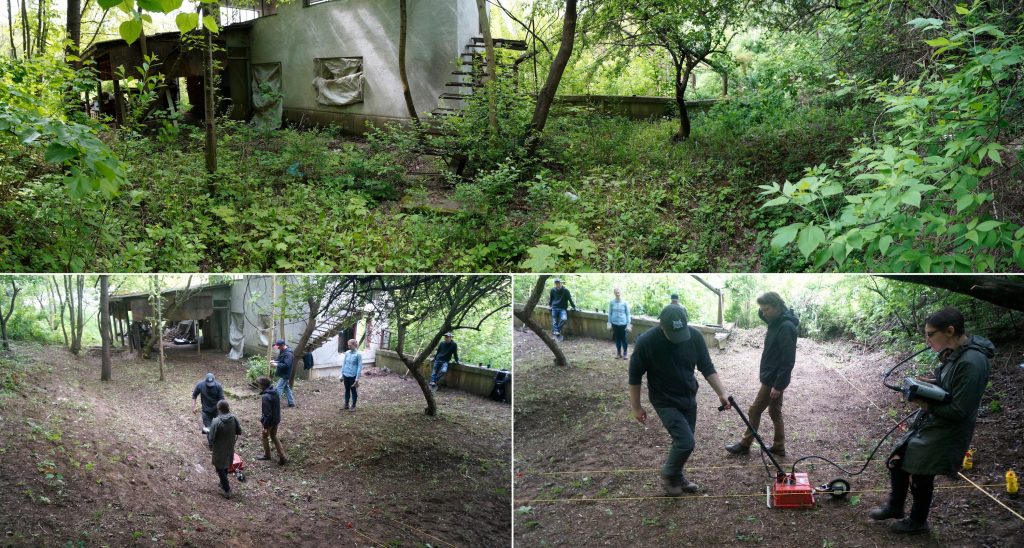
A panorama of the north mass grave site before clearing (top) and two views after clearing,
during the survey (bottom). Photos © 2019 RJH.
Tuesday morning, the Staffordshire team and the other continuing volunteers (Steve, Carson, Ethan, Andrés, Vasyl, Marla, and I) raked and gathered the remaining small plant debris from the entire survey area, plus as much broken greenhouse glass and other hard debris as we could remove to outside the marked boundaries; this cleaning effort continued even as the archaeologists began their radar survey. Traversing the survey grid in 1m-wide “slices”, data was collected within all of the accessible area next to the northern greenhouse, up the steep slope of the adjacent hill, across a deep ditch where water runoff is collected, and under the overhanging abandoned building which overlooks this section of the complex. As they are accustomed to doing, the team worked around large trees, metal poles, and the ruined frame of an old stairway as carefully they made their way across the grid. Our cellphones turned off to prevent interference with the instrumentation, we watched as the survey completed. The collected data will be analyzed in their offices in the UK, after which the archaeologists will publish a supplemental report to include this new data with their results from 2017.
The slow and careful radar survey process provided some time to reflect on what had happened at this site during the war, and to discuss how researchers and many others are working to document, analyze, and memorialize the events and the people involved. The Staffordshire team has extensive experience working at Holocaust sites in Europe, and Kevin took time to answer questions from the volunteers who had helped to prepare the ground.
After a final group picture, we bid the Staffordshire team farewell and they departed for Lviv, and the remaining PCVs and other volunteers walked into town to catch buses to return home, Marla and Vasyl and I stayed at the north mass grave site to clear grass and new shrub growth around the memorial monuments at the edge of the site. We will return again to this site with friends and colleagues on June 6th of this year for another memorial event, marking the 76th anniversary of the 1943 aktion which took the lives of thousands of Jews from the Rohatyn ghetto, including many originally from surrounding towns and villages.

The grass and weeds around the northern memorial monument, before and after mowing. Photos © 2019 RJH.
South Mass Grave Site
Before and after the main volunteer event, Vasyl and Marla and I also visited the mass grave site south of Rohatyn’s town center to do some light clearing around the memorial monument from 1998, and to experiment with cutting down and dispersing the large growth of poisonous heracleum there. For now our goal is only to make the monument more visible and accessible, and to start our learning about managing the noxious plant. Rohatyn Jewish Heritage has a larger rehabilitation project for this site in design and planning stages with a professional landscaping firm now, and we will return to the site from time to time during 2019 to maintain it until we know how and when that larger project may proceed.
Exploring Rohatyn’s Past and Present
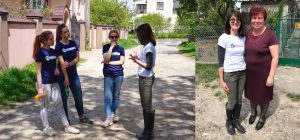
On one of the tours in the old Jewish quarter of Rohatyn, and meeting a long-time friend in the neighborhood. Photos © 2019 RJH.
To help provide historical context to the heritage sites where we all worked, and to introduce the past Jewish community of Rohatyn as a part of the multicultural history of the town, Marla led two tours for the volunteers to the town square, the historic Jewish residential and religious quarter nearby, and the several Jewish burial grounds; most of the volunteers had already visited the historic UNESCO-listed wooden Holy Spirit Church, and had seen the wooden St. Mykolay church from the old Jewish cemetery as well.
Besides these conventional cultural tours, we were also very pleased to invite all the volunteers with us Monday evening for a dinner of salad, pizza and drinks at the ElitCentre restaurant in town. It was another enjoyable new tradition for all of us!
Looking Forward
Thanks to the determined efforts of the many volunteers, Rohatyn Jewish Heritage counts this first major heritage rehabilitation event for 2019 as a significant success, and an excellent start to our “outdoor” season. We are seeing progress in the preparation of the heritage sites for more sustainable care, and in our tools, knowledge, and skills for managing the ongoing work. Equally important to us, with the engagement of local citizens and visitors from abroad, we are encouraged that Rohatyn’s Jewish heritage will gradually become a visible part of the city’s cultural landscape, and that Rohatyn is becoming a welcoming city for visitors of all origins and backgrounds.
We are now planning the next volunteer events at these sites in 2019; please follow our Facebook page and our calendar on this news site for announcements about those future events!

